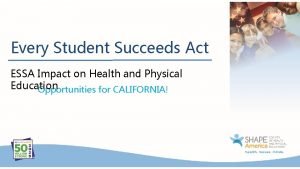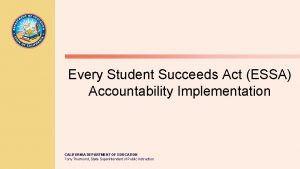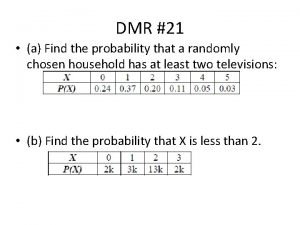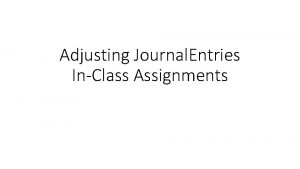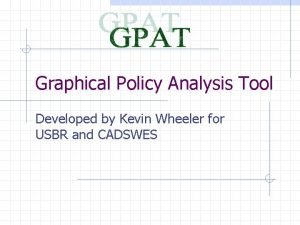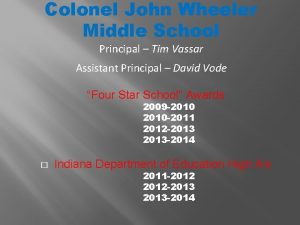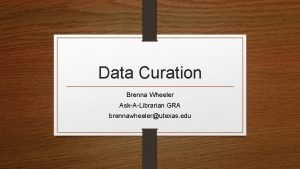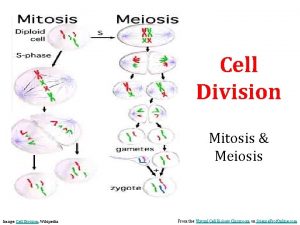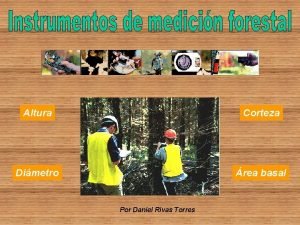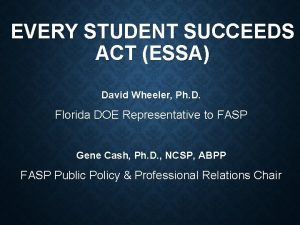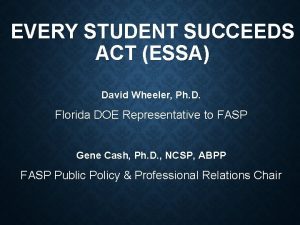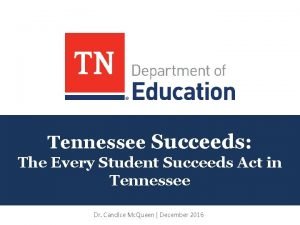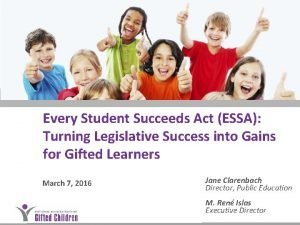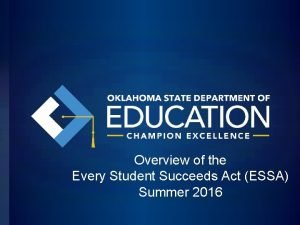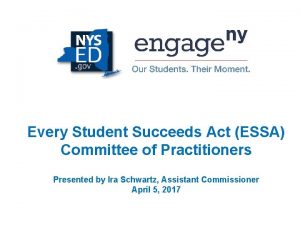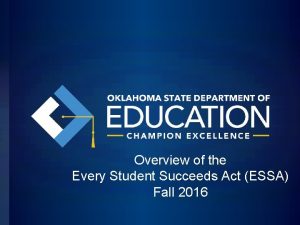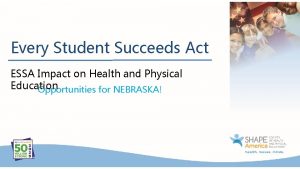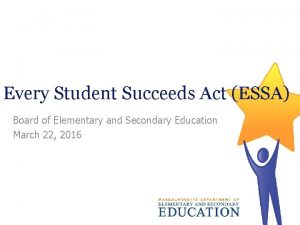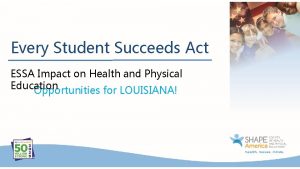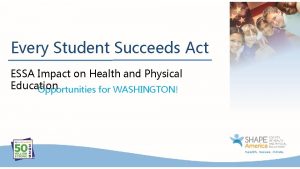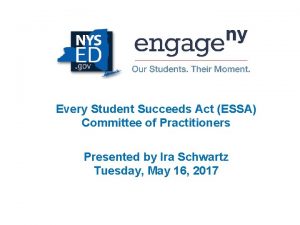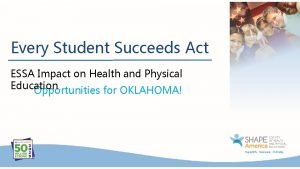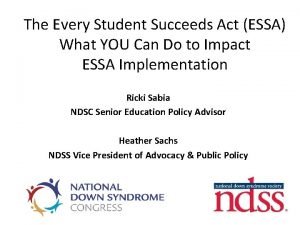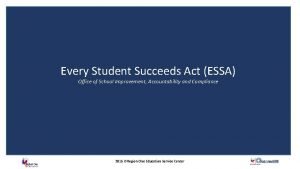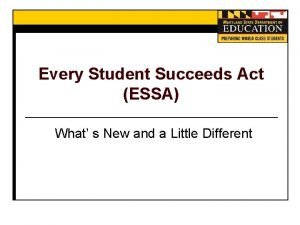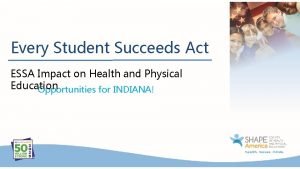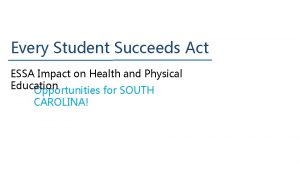EVERY STUDENT SUCCEEDS ACT ESSA David Wheeler Ph







































- Slides: 39

EVERY STUDENT SUCCEEDS ACT (ESSA) David Wheeler, Ph. D. Florida DOE Representative to FASP Gene Cash, Ph. D. , NCSP, ABPP FASP Public Policy & Professional Relations Chair

Current Opportunities 2

Major Public Policy Issues in Education • International Competition – College/Career Readiness Addressing Disparate Discipline Practices Halting the School to Prison Pipeline Closing Achievement Gaps Teacher/principal (and Specialized Instructional Support personnel) accountability Balance Federal/State/Local roles School Climate School Safety Improving behavioral, social-emotional, and mental health • • 3

Major Education and Mental Health Themes in 2016 -17 Presidential and Congressional elections p Reauthorization of the Elementary and Secondary Education Act (ESEA-NCLB) as the Every Student Succeeds Act (ESSA) p Diploma Act (H. R. 495) p Safe Schools Improvement Act (S. 311) p Homeless Children and Youth Act 2015 (S. 256) p Mental Health in Schools Act (HR 1211) p National School Psychology Week (Nov. 9 -13) p The Patient Protection and Affordable Care Act p

Reauthorization of the Elementary and Secondary Education Act (ESEA – NCLB - ESSA) Seven years overdue (scheduled for 2008) p Attempts to pass a reauthorized bill were made in the 112 th Congress p Little progress was made in the 113 th Congress (January 2013 -January 2015). Finally signed into law Dec. , 2015. p NASP has helped to ensure, among other things, that the role of the school psychologist is explicitly mentioned in law p Voices of individual school psychologists are vital to building support within Congress for any necessary regulatory changes p

What is ESEA (now ESSA)? p p p The largest source of federal spending on primary and secondary education. President Johnson originally signed ESEA into law in 1965 to represent the federal government's new commitment to equal and quality education for all. ESEA emphasized equal access to education for all students and additional resources for vulnerable students. Encouraged high standards for academic achievement from students, teachers, administrators, and parents, and demanded accountability from schools. ESEA offered grants to underserved districts, federal grants for textbooks and special education centers, as well as scholarships for low-income college students. ESEA was designed to ensure that the federal government would continue to invest in education; students, teachers, and administrators would remain committed to equal and quality education; and that achievement gaps would continue to close.

What was NCLB? p p p p NCLB was signed into law by President George W. Bush in 2001. It changed the philosophy of education in the US! It was the reauthorization of ESEA and included Title I. NCLB exposed achievement gaps and created a national dialogue on the importance of closing them. It promoted accountability for all children to succeed and required transparency. It emphasized punishing failure over rewarding success. It focused on test scores rather than growth, and created onesize-fits-all interventions for schools. In 2012 the Obama Administration offered some flexibility to states under the law, but states had to prove that they were adopting and implementing components from NCLB and had to continue to be transparent about their progress.

NASP NCLB Reauthorization Principles 1. Student health and well-being are integral to student success. p 2. School mental health services promote academic and social emotional success for all children. p 3. Student outcome measures must extend beyond literacy and numeracy to encompass factors such as student health and wellbeing, school climate, and school safety. p

NASP NCLB Reauthorization Principles 4. Accountability systems should reflect a comprehensive picture of students’ and schools’ performances. p 5. School personnel need to deepen their knowledge of and expertise in research-based practices that help students overcome barriers to learning. p 6. Common elements of IDEA and NCLB need to be explicitly linked to each other in both policy and practice. p 7. The President and Congress need to increase authorized ESEA/NCLB funding levels. p

ESEA – NASP Recommendations to Congress p p p Maintain high expectations and strong accountability for student learning. Encourage school districts to implement evidence-based multitiered systems of support (e. g. , PBIS and RTI) that focus on prevention of and intervention for academic, behavioral, social, emotional, and mental health difficulties. Promote policies ensuring that instruction, assessment, and interventions are responsive to individual student needs. Ensure that students are free to learn in an environment that is free of bullying, harassment, and discrimination. Ensure that all students have access to coordinated school psychological services. Ensure that all schools have sufficient access to specialized instructional support personnel, such as school psychologists.

Every Student Succeeds Act (ESSA) p p p ESSA replaces NCLB and makes some significant changes impacting specific policies and practices at the state, local, and school building level. Tends to shift decision-making away from the federal government and toward the states. NASP will need the help of school psychologists in making sure that states and districts implement high quality, evidence-based school improvement efforts, that utilize the skills and expertise of school psychologists. ESSA takes effect in the 2017 -2018 school year, and many states and districts will have to make significant changes to comply with the law. The Department of Education has resources to help states transition to ESSA. Further, the regulatory process, which specifies how certain parts of the law must be implemented, began in January, 2016. NASP is working with various federal agencies to ensure that the importance of comprehensive school psychological services is recognized in regulation, guidance documents, and technical assistance materials released by the Department of Education.

ESSA State Plan p p p ESSA regulations should be finalized in the coming months. The state plan is tentatively due either in March or July, 2017, according to the proposed regulations. A draft of the state plan will be posted for at least 30 days prior to submission for additional public comment. Once submitted, plans will undergo a peer review process and USED has 120 days after submission to respond to the plan. Current proposed regulations require the use of 2016 -2017 results in 2017 -2018; however, the timeline does not support use of a new ESSA-compliant accountability system in 2017 -2018, let alone 2016 -2017. Based on when the plans are due and review time by USED, it appears that full implementation would occur at the earliest in 2018 -2019. • While it is too early to make definitive decisions on ESSA, these circumstances afford us ample time for discussion and input from stakeholders.

Adelman and Taylor’s Concerns http: //smhp. psych. ucla. edu/pdfdocs/improv eessa. pdf

The Every Student Succeeds Act: Opportunities for School Psychology

ESSA Offers New Opportunities • Shift of control from federal to state and local jurisdictions (Risk and Opportunity!) • Engagement of stakeholders in decision making (SISP) and accountability measures and systems • More flexible funding streams • More comprehensive, less prescribed accountability measures • Emphasis on mental/behavioral health and school climate/safety • Added resources for foster children and youth • Risk of reduced attention to children with special needs; masking outcomes for these populations

Key ESSA Definition: Specialized Instructional Support Personnel (SISP) "(i) school counselors, school social workers, and school psychologists; and "(ii) other qualified professional personnel. . . involved in providing assessment, diagnosis, counseling, educational, therapeutic, and other necessary services (including related services as that term is defined in section 602 of the Individuals with Disabilities Education Act (20 U. S. C. 1401) as part of a comprehensive program to meet student needs. “

http: //www. nasisp. org National Alliance of Specialized Instructional Support Personnel (NASISP)

Key ESSA Definition: School Based Mental Health Services Provider “. . includes a State-licensed or State-certified school counselor, school psychologist, school social worker, or other State licensed or certified mental health professional qualified under State law to provide mental health services to children and adolescents. ”

Key ESSA Definition: Multi-tiered System of Supports (MTSS) “The term ‘multitier system of supports’ means a comprehensive continuum of evidence-based, systemic practices to support a rapid response to students’ needs, with regular observation to facilitate data-based instructional decision making. ’’

Key ESSA Definition: Evidence-based ‘Evidence-based’ means an activity, strategy, or intervention that: • Demonstrates a statistically significant effect on improving student outcomes or other relevant outcomes based on: – Strong evidence from at least 1 well-designed and wellimplemented experimental study; or, – Moderate evidence from at least 1 well-designed and well- implemented quasi-experimental study • Demonstrates a rationale based on high quality research findings or positive evaluation that such activity, strategy, or intervention is likely to improve student outcomes or other relevant outcomes; and includes ongoing efforts to examine the effects of such activity, strategy, or intervention.

The Good News about SISP & School Based Mental Health Services Provider • Includes school psychologists as key stakeholders in alignment with the School Psychology Practice Model. • ESSA references (and in some cases mandates) specialized instructional support personnel and services more than 40 times in policies regarding state and district school improvement plans; identifying and supporting students most at risk of school failure; improving student literacy; addressing school climate and school safety; supporting the mental and behavioral health of students.

Key ESSA Policies Relevant to School Psychological Services & Practice • Standards, Assessment, & Accountability Systems • School Improvement & Support • School Climate, School Safety, and Comprehensive Learning Supports

Standards, Assessment, and Accountability • States must set challenging standards and performance goals for all students. • Replaces AYP w/ a comprehensive accountability model to support struggling schools. • Requires meaningful consultation with stakeholders, including SISP in the design of state plans, as well as school improvement plans to improve student outcomes and school success.

State accountability system must: • Include performance goals for subgroups • Annually measure student performance • State assessment • At least one other academic indicator (student growth) • Include at least on indicator of school quality for student success (e. g. , student engagement; school climate)

School Improvement Efforts • State and district driven improvement plans • Must utilize needs assessment and examination of resource equity • Include availability of comprehensive learning supports • Requires involvement of specialized instructional support personnel

Comprehensive Support & Improvement • Identify schools that fall in this category (every 3 years) – Bottom 5% of schools – HS Grad Rates < 67%, – Schools w/ subgroups who have consistently underperformed • Comprehensive Support & Improvement plans are approved & monitored by SEA • If schools fail to make progress – Conduct needs assessment – Implement evidence-based, comprehensive learning supports – Identify & plan to address resource inequity

Targeted Support & Improvement • Identify individual schools in which any subgroup of students is consistently underperforming (yearly). • Schools, in collaboration with the LEA, must develop plan to improve outcomes for the subgroup • Plan must outline how Specialized Instructional Support Personnel will help identify and intervene w/ students most at risk. • Schools may use Title I funds to implemental health services as an improvement strategy.

Targeted Support & Improvement Targeted assistance programs must serve eligible children using methods and instructional strategies to strengthen the academic program, which may include "a school-wide tiered model to prevent and address problem behavior, and early intervening services, coordinated with similar activities and services" under the IDEA. – Sec. 1115(b)(2)(B)(ii)

School Climate, School Safety, and Comprehensive Learning Supports • States must annually report school climate, bullying and harassment data & assist districts in reduce incidence. • School based mental health programs and specialized instructional support services are allowable school improvement strategy – Flexibility for SEA and LEA to determine specific practices to improve school climate, school safety, and comprehensive learning supports. • Funding - Can use Title I, Title II and/or Title IV funds. At least 20% of Title IV Part A funds must be used for at least one activity to improve overall student wellbeing

LEA can use ESSA funding to: • Implement multi-tiered systems of support to address the academic, social-emotional, behavioral, & mental health needs of all students. • Implement positive behavior intervention & supports and early intervening services. • Improve school climate & safety. • Increase access to school mental health and behavioral health services. • Implement trauma informed practices & mental health first aid. • Improve effectiveness of school/community partnerships.

LEA can use ESSA funding to Offer PD to School Staff for: • Alignment of activities to specific school improvement efforts; • Collaborative data collection and decision making; • Increased educator capacity within multi-tiered systems of support; • High quality instruction, supports, & interventions for diverse learners; • Knowledge of culturally competent practices.

Current Reactions to Law Pros (Hopes) • Scales back intrusive Federal Role • Prohibits mandate of Common Core or other standards • Authorizes significant increases in funding for Title I and Title IV (e. g. , comprehensive learning supports) • Comprehensive Accountability System • Increase focus on importance of specialized instructional support personnel • Early childhood focus Click to edit subtitle style Cons (Cautions) • Weakens Federal oversight authority on accountability • Lowered standards/expectations for certain populations of students • Lack of district and state capacity • Fear of unintended consequences • Pay for Success Programs • Lack of consequences when states/districts don’t improve outcomes for certain groups of students

ESSA & School Psychology • Assessment & Accountability Systems – Must include SISP in designing SIP – Assess academic progress & another indicator of student growth – Must measure one indicator of school success • Schools in Need of Improvement – Needs assessment, implement learning supports, address resource inequity – Plans must outline how SISP involved and may fund SMH • Improving school climate, safety, & access to comprehensive learning supports – Must report school climate and school safety data – Remedies could include MTSS, PBS/PBIS, SBMH, TIC practices, school-community partnerships, PD


ESSA Implementation Resources • Significant opportunities for school psychologists • Emphasizes mental health, school climate and safety, MTSS, and comprehensive assessment/accountability • Resources include handouts for SPs and decisionmakers, podcasts, funding opportunity information, etc. • SP involvement in state and district policy and regulatory decisionmaking is critical http: //www. nasponline. org/essa

FLORIDA IMPLEMENTATION OF ESSA http: //www. fldoe. org/academics/essa. stml 39

FL Public Comments – July 2016 § FDOE reached out to at least 130 stakeholder groups; 912 individuals responded to the survey. § Most respondents were in favor of ESSA § Most urged the use of school and community resources, continuing Florida practices, and providing accommodations in testing. § Most respondents were in favor of proportional distribution of district funds, rather than a competitive grant-based system § Differed on the use of state and locally developed tests compared to using national assessments. § Differed on issues surrounding accountability and high-stakes testing. § Comments and summary report posted at http: //www. fldoe. org/academics/essa. stml 40


ESSA Update – DPS: 2016 -147, Oct. 23, 2016 § Regulations should be finalized soon https: //www. gpo. gov/fdsys/pkg/FR-2016 -05 -31/pdf/201612451. pdf § Commissioner Stewart’s response to draft Regulations http: //www. fldoe. org/core/fileparse. php/14196/urlt/FDOER esponse. USDOE. pdf § Draft of state plan will be posted for at least 30 days prior to submission for additional public comment § State plan due in either March or July of 2017 § 2017 -18 School Year – ESSA effective for grant programs, assessments, & accountability systems § 2017 -18 School Year – Identify schools for comprehensive intervention § Full implementation by the 2018 -19 school year 42
 Every student succeeds act california
Every student succeeds act california Tony essa
Tony essa La s sorda i la s sonora
La s sorda i la s sonora Eprg model
Eprg model A company that rents dvds from vending machines
A company that rents dvds from vending machines David essa
David essa Every nation and every country
Every nation and every country Empower every person and every organization
Empower every person and every organization Every knee shall bow every tongue confess
Every knee shall bow every tongue confess Every rotarian every year
Every rotarian every year Every nation and every country
Every nation and every country Every picture has a story and every story has a moment
Every picture has a story and every story has a moment Every child every day
Every child every day Macbeth act 3-5 summary
Macbeth act 3-5 summary Every student deserves a great teacher
Every student deserves a great teacher Qs 3-6 prepaid (deferred) expenses adjustments lo p1
Qs 3-6 prepaid (deferred) expenses adjustments lo p1 Conception of curriculum
Conception of curriculum Mortimer wheeler soil layer method
Mortimer wheeler soil layer method Christa wheeler
Christa wheeler Pistola haga forestal precio
Pistola haga forestal precio Bob wheeler tool time
Bob wheeler tool time Colonel john wheeler middle school
Colonel john wheeler middle school Whittaker modificado
Whittaker modificado Jean wheeler
Jean wheeler How to calculate the total surface area
How to calculate the total surface area Brenna wheeler
Brenna wheeler Mtosis
Mtosis Calibrador de corteza
Calibrador de corteza Richard wheeler
Richard wheeler Chromosome
Chromosome Cosette wheeler
Cosette wheeler Wheeler kutu plankaresi
Wheeler kutu plankaresi Alexandra wheeler
Alexandra wheeler Modelo curricular de wheeler
Modelo curricular de wheeler Wheeler dewitt equation
Wheeler dewitt equation Herbert wheeler
Herbert wheeler Wheeler dewitt equation
Wheeler dewitt equation Colleen abbott
Colleen abbott Brenna wheeler
Brenna wheeler Last weekend essay
Last weekend essay
